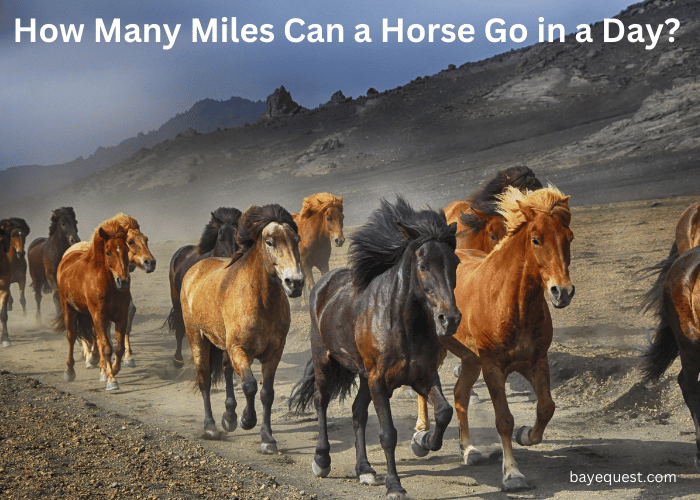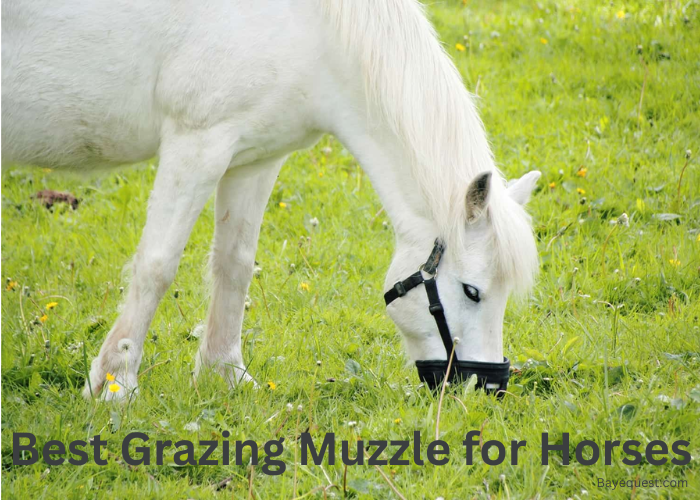A horse on the move is a sight to behold. With strong legs and a spirit of adventure, these animals are built to cover ground.
But how far can they go in a day? Is it 20 miles? Maybe 50? The answer depends on many things—like the horse’s breed, the terrain, and how fit the horse is.
Whether on a calm stroll or a speedy gallop, each journey tells its own story. Let’s dive in and explore the distances these incredible creatures can travel.
How Many Miles Can a Horse Go in a Day? Key Takeaway
An average horse can travel 25 to 35 miles (40-56 km) in a day with a rider, depending on its fitness and terrain. However, pushing a horse to cover this distance daily is not sustainable. For long journeys, covering 15 to 25 miles (24-40 km) per day is more manageable for the horse’s health.
How Far Can Horses Travel in a Day?
The distance a horse can travel in a day depends on several factors, including its breed, health, conditioning, terrain, and the weather. Generally, a healthy horse can travel about 25 to 35 miles daily at a moderate pace on reasonable terrain.
However, there are exceptional cases where endurance-trained horses can cover up to 50 miles or more.
Distances tend to be shorter for recreational purposes and to ensure the horse’s well-being to avoid overexertion. The key to maximizing a horse’s travel distance is proper preparation, good conditioning, and attentive care to its needs.
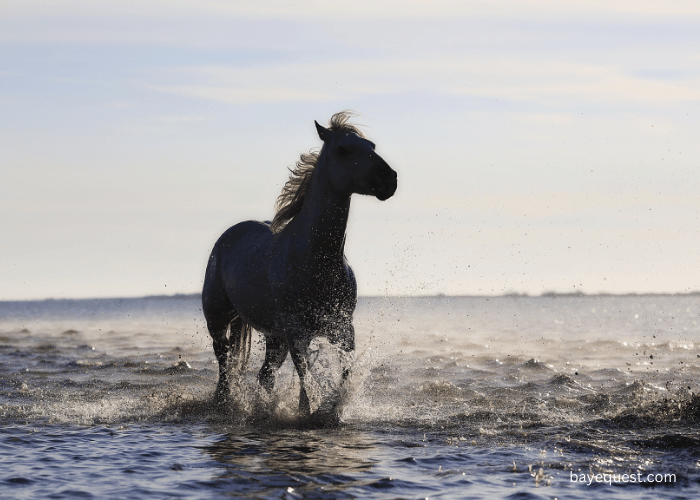
How Far Can a Horse Travel in One Hour?
A horse can cover quite a bit of ground in one hour. On average, if they’re walking, they might travel about four to five miles.
It could stretch to eight to twelve miles if they pick up the pace to a trot. And at a gallop, they could zip through fifteen to twenty miles, but that’s pushing it and isn’t sustainable for long periods.
Of course, these numbers can vary greatly depending on the horse and the trail or road conditions.
How Far Can a Horse Travel in One Week?
A horse can travel quite a distance in a week. If we’re talking about a horse in good shape and with consistent, daily travels, it might cover anywhere from 150 to 200 miles over seven days.
This assumes we’re giving the horse proper rest each night and not pushing it too hard. Remember, like people, horses need downtime to rest and recover, especially after long stretches on the road.
How Far Can a Horse Travel Without Stopping?
A horse can travel a certain distance without stopping, but it really depends on the pace and the conditions. Generally, a horse might manage 20 to 30 miles without a break if it’s walking or trotting.
However, continuous travel without stops isn’t ideal for the horse’s health. Frequent rests are important to prevent fatigue and overexertion.
How Fast Can A Horse Go At Top Speed?
A horse’s top speed can vary based on the breed and individual condition. Generally, a horse can gallop at speeds up to 40 to 48 miles per hour in short bursts.
Thoroughbreds, often used in racing, are among the fastest breeds and can reach these peak speeds. However, sustaining such high speeds is only possible for short distances, like in a sprint.
How Fast And How Far Can A Horse Travel With A Rider On Its Back?
With a rider on its back, a horse’s speed and distance can vary depending on several factors.
However, a horse can trot at about 8 to 12 miles per hour and can sustain this pace for a few hours. The speed increases to about 25 to 30 miles per hour at a gallop, but this pace can only be maintained for short distances.
How Fast Can a Horse Travel at Each Gait?
A horse has 4 gaits, each with its own speed. Understanding these gaits helps you choose your horse’s appropriate speed and endurance levels.
You can optimize travel efficiency by matching the gait to the terrain, distance, and travel conditions.
| Gait | Description | Speed |
| Walk | A slow, steady four-beat movement. | 4 mph |
| Trot | A quicker, two-beat diagonal movement. | 8-12 mph |
| Canter | A smooth, three-beat gait. | 12-15 mph |
| Gallop | The fastest four-beat gait. | 25-30 mph |
Factors that Influence How Far a Horse Can Travel in a Day
Several elements play a crucial role in determining how far a horse can travel in a day. Let’s explore some of them:
1. Breed
Different horse breeds have different capabilities. Arabians, for example, are known for endurance. They can travel longer distances than many other breeds.
Thoroughbreds, on the other hand, excel in speed. They are great for short, fast bursts.
Breeds affect how far and how fast a horse can go. This is because each breed has unique physical traits. These traits determine their stamina and speed.
2. Age
A horse’s age plays a big role in its performance. Young horses, or foals, aren’t suitable for long rides because they’re still developing.
Older horses might lack the stamina of their younger selves. The prime age for a horse in terms of stamina and speed is between 5 and 15 years.
Younger horses need to build muscle and experience. Older horses might need to slow down a bit.
3. Overall health
A healthy horse can go faster and farther. Health issues can slow a horse down.
This might be due to pain, stiffness, or general weakness. Regular check-ups are key. They ensure the horse is fit for travel.
A horse in top health will perform better. It will have more energy to maintain a steady pace over distances.
4. Conditioning and training
Training is crucial. A well-trained horse can better manage its energy and travel at a consistent speed for longer.
Regular exercise builds muscle and stamina. Horses that aren’t conditioned might tire quickly and can’t maintain high speeds for long. Consistent training routines prepare a horse for longer journeys.
5. Terrain
The ground matters. Rocky or uneven terrain slows a horse down. It’s also more tiring.
Flat and smooth terrain allows for faster speeds. Horses need to be familiar with the terrain type.
Training on similar surfaces can help. This prepares them for the conditions they will face.
6. Weather
Weather affects how far and fast a horse can go. Extreme heat can lead to overheating. Cold can stiffen muscles.
Ideal conditions are cool and dry. This allows horses to maintain a good pace without overheating.
As a rider, consider weather forecasts. It’s best to avoid harsh conditions.
7. Weight
The weight a horse carries influences its speed and endurance.
Heavier loads slow a horse down. They also tire it out faster. This includes the rider’s weight and any gear. Lighter loads allow for quicker travel.
You need to balance the load. This ensures the horse can travel comfortably without strain.
8. Rider’s experience
A skilled rider makes a difference. Experienced riders know how to manage a horse’s pace.
They can prevent unnecessary energy use. This means the horse can travel faster and for longer periods.
Novices might not recognize when a horse needs to slow down. This can lead to early fatigue.
9. Feed and water
Nutrition is fuel. High-quality feed and ample water boost a horse’s stamina. They allow it to maintain speed over long distances.
Dehydration or poor nutrition can slow a horse down. It can even stop it from traveling. Regular breaks for water and feeding are essential during long trips.
Related read: How Much Can a Horse Pull?
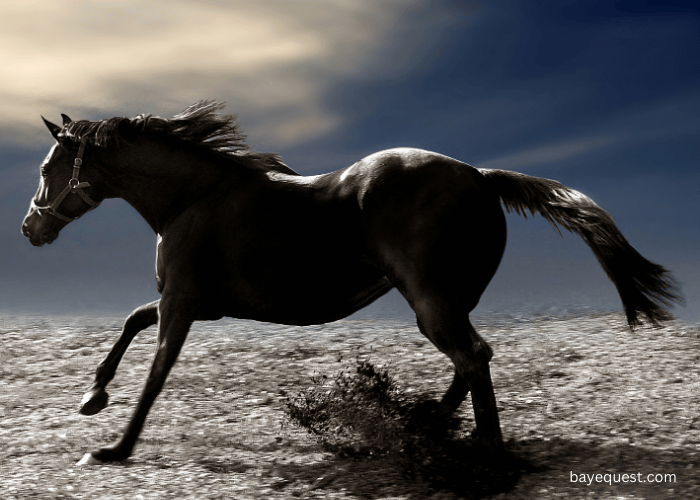
Great Endurance Horse Breeds
Great endurance horses include:
Arabians
Arabian horses are celebrated for their stamina and endurance. Originating from the Arabian Peninsula, these horses are built to handle harsh desert conditions.
They have a distinctive head shape and high tail carriage. Arabians are usually the first choice for long-distance endurance races because they can maintain a steady pace for miles.
Their strong bones, efficient hearts, and good temperament contribute to their endurance prowess.
However, this breed isn’t just about stamina. It is also known for its speed and agility, which makes it versatile.
The cost of an Arabian horse can vary widely based on factors such as age, pedigree, training, and conformation.
Mustangs
Mustangs are free-roaming horses of the American West that descended from horses brought to America by the Spanish. They are known for their ruggedness and versatility.
Living in the wild has equipped Mustangs with resilience and the ability to navigate challenging terrains. This breed is highly valued in endurance riding due to its hardiness and ability to adapt to varying conditions.
Mustangs are not just survivors. They have remarkable stamina, which comes from generations of living in demanding environments.
Morgans
Morgans are among the oldest American horse breeds. They are known for their versatility and willingness to work. They are compact and refined, with strong limbs that make them excellent for endurance.
Morgans possess a remarkable trotting ability that allows them to cover long distances. This breed is known for its easygoing nature and ability to form strong bonds with humans.
Morgans are also celebrated for their ability to maintain a consistent performance over long periods.
Regarding the cost, Morgan horses can vary in price depending on several factors such as age, pedigree, training, and their specific abilities. Generally, prices for Morgan horses range from $1,000 to $5,000 for a basic riding horse.
Mongolian
Mongolian horses are a breed that’s as rugged as the terrain they come from. These horses are used to the harsh conditions of Mongolia and have developed incredible stamina and hardiness as a result.
They are smaller in stature, but don’t let their size fool you. These horses are incredibly tough and can travel long distances over challenging steppes.
Traditionally used by nomadic tribes for transportation, they are a testament to what endurance means in a horse.
Akhal-Teke
The Akhal-Teke from Turkmenistan is known for its speed, endurance, and distinctive metallic sheen. This breed is one of the oldest and most refined horse breeds.
They were used for long raids and could cover incredible distances without much water or food, a trait vital in arid climates.
Their slim, athletic build allows them to move swiftly and efficiently.
Thoroughbred
Thoroughbreds, often associated with horse racing, are also capable of impressive endurance. Originally bred in England for stamina and speed, they are excellent at galloping at high speeds over medium distances.
Thoroughbreds are valued for their quick recovery rates and ability to handle varied terrains.
While they may not have the raw endurance, their heart, and competitive spirit make them the best choice in endurance disciplines.
Anglo-Arabian
The Anglo-Arabian is a cross between Thoroughbred and Arabian horses. This breed inherits the best traits of both, making it suited for endurance riding.
They have a larger frame than pure Arabians, which can be beneficial in covering more ground. Anglo-Arabians are known for their stamina, speed, and excellent temperament, making them popular choices for competitive endurance riding.
American Quarter Horse
This horse is renowned for its sprinting capabilities, especially over short distances. However, they also possess notable stamina and versatility.
While not the typical endurance racehorse, Quarter Horses are incredibly durable and can handle long rides at a more moderate pace.
They are particularly good for trail riding and activities that require bursts of speed and stamina over varied terrain.
In terms of price, Quarter Horses are among the most affordable and widely available breeds in the United States. Prices for Quarter Horses can range from around $1,000 for a basic trail or pleasure horse to over $50,000 for a top competition horse.
Missouri Fox Trotter
Missouri Fox Trotters have an ambling gait, allowing them to travel long distances quickly without tiring. This breed is popular among trail riders and endurance riders who prefer a comfortable ride over challenging terrain.
Their unique gait helps reduce rider fatigue and provides a steady and reliable journey, making the Missouri Fox Trotter an excellent choice for extended outings.
Criollo
Originating from South America, Criollos are known for their hardiness and endurance. They are small, sturdy horses bred to survive the harsh conditions of the pampas and mountainous regions.
Criollos are remarkable at conserving energy over long distances. They are also very agile, which helps them navigate rough terrain easily.
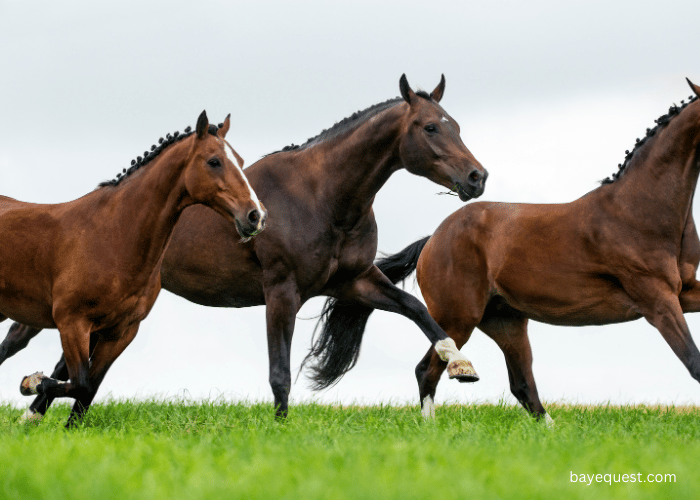
Training Horses For Big Rides
Training horses for big rides is about building strength, stamina, and trust. Here’s how you can do it: keeping things simple and clear.
Start slow: Begin with short, easy rides. Just like humans, horses need to start slow. Gradually increase the distance and difficulty. This helps your horse build muscle and endurance without the risk of injury.
Consistency is key: Train regularly, make a schedule, and stick to it. Consistency helps your horse get into a routine, making the training process smoother and more effective.
Mix it up: Vary the training routine. Include different terrains and paces. This prepares your horse for various challenges during a big ride and keeps the training interesting for them.
Focus on nutrition: Pay attention to what your horse eats. A well-fed horse has the energy for long rides. Provide a balanced diet rich in nutrients. And always ensure they have plenty of water, especially on training days.
Build a bond: Trust between you and your horse is crucial. Spend time with them outside of training. Groom them, talk to them, and learn their behaviors. A horse that trusts you will perform better.
Rest and recovery: Allow ample rest. Horses, like athletes, need downtime to recover after intense workouts. Rest days are essential to prevent fatigue and injuries.
Listen to your horse: Pay attention to how your horse reacts to training. If it seems tired or reluctant, it might be time to ease up. Pushing too hard can lead to setbacks.
Pacing And Rest Over Long Rides
Pacing and rest are crucial when it comes to long rides with horses. Here’s a straightforward approach to managing both effectively.
Start steady: Begin the ride at a steady pace. Avoid rushing at the start. This helps your horse conserve energy for the long haul. A consistent, manageable pace keeps them from tiring out too quickly.
Know the signs: Watch for signs of fatigue in your horse. Drooping ears, heavy breathing, or a sluggish gait mean it’s time to slow down. Recognizing these signs early helps prevent exhaustion.
Regular breaks: Take breaks regularly. Just like us, horses need time to catch their breath. Short stops during a long ride can make a big difference. Allow your horse to drink water and relax a bit before continuing.
Mix up the gait: Change the gait periodically. Switch between walking, trotting, and cantering. This variation uses different muscle groups to help prevent muscle fatigue.
Long rests: Plan for longer rest periods too. If you’re on a multi-day ride, ensure your horse has a good night’s rest. A comfortable, quiet place to sleep and recover is vital.
Feed well: Don’t forget about nutrition. During breaks, offer your horse high-energy feed. This keeps their energy levels up and aids in their recovery.
Finish calmly: End your ride as calmly as you started. Cooling down is as important as warming up. It helps your horse’s muscles relax and return to normal.
Read also: How to make a horse barn.
Safety And Equipment On Long-Distance Travel
When you’re planning a long-distance ride with your horse, safety and the right equipment are key. Here’s how to keep both you and your horse safe and comfortable.
Safety first: Always wear a helmet. It’s your best protection in case of a fall. Make sure it fits well and is secured properly.
Check your tack: Before you head out, inspect all your tack for wear or damage. This includes saddles, bridles, stirrups, and girths. Everything should be in good condition to ensure your horse’s comfort and your control.
Pack essentials: Bring the horseback riding essentials. This includes a first-aid kit for both you and your horse. Also, don’t forget maps, a compass, or a GPS device. Even if you know the trail, it’s good to be prepared.
Weather appropriate gear: Dress for the weather. Wear layers if it’s cold. If it’s hot, light-colored, breathable fabrics are best. Protect yourself from rain or strong sun as needed.
Reflective gear: Wear reflective gear on both you and your horse. This is crucial if you might be out in the dark or in low-visibility conditions. It helps others see you clearly.
Communication: Carry a means to communicate. A mobile phone is good, but consider a satellite phone or a two-way radio in remote areas.
Food and water: Pack plenty of food and water. You need enough for both you and your horse. Remember, a hydrated horse is a happy horse.
Practice loading: If you’re transporting your horse to the starting point, practice loading and unloading. Make it as stress-free as possible. The ride should start on a calm note.
How Many Miles Can a Horse Travel in a Day? FAQs
What is the longest horse endurance ride in the world?
The Mongol Derby is the longest horse endurance ride in the world, approximately 1,000 kilometers (about 621 miles) long. It traces the historical mail delivery routes established by Genghis Khan across Mongolia.
What is the shortest time a horse has completed 100 miles?
The shortest time a horse has completed a 100-mile endurance ride is 5 hours, 45 minutes, and 44 seconds. This record was set during the 2010 Crown Prince Endurance Cup in the UAE. This achievement marks one of the fastest times recorded for a 100-mile horse endurance race.
Related read: Race Horse Top Speed.
How far can a horse jump?
A horse can jump three times its own length. The world record is a whopping 27 feet and 6.75 inches. This was set back in 1975 by a horse named Something, with André Ferreira in the saddle.
How fast can a horse swim?
Horses are good swimmers, and while their swimming speed varies, they can generally swim at speeds up to 2 to 4 miles per hour. The speed can depend on the horse’s size, strength, and familiarity with swimming. Horses don’t swim as part of official competitions but often during training or rehabilitation sessions.
Read more on how fast horses can swim in our other guide.
How Far Can a Horse Go in a Day? Conclusion
As we’ve explored how far a horse can travel in a day, it’s clear that every horse is different. From the tough Mustangs roaming the American West to the swift Arabians of the desert, each horse has its own strengths.
Whether you’re setting out for a relaxed trail ride or preparing for a serious endurance race, knowing your horse’s abilities is key. So, next time you hop into the saddle, remember it’s more about enjoying the journey together than just covering ground.
Every ride with your horse is a chance to create lasting memories and go on new adventures.




